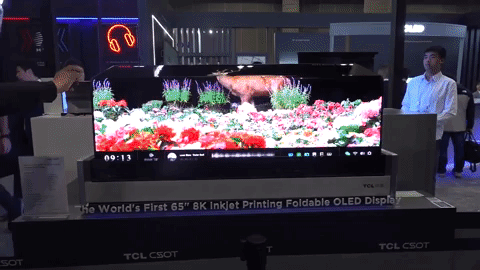
The world of OLED TVs is always innovating. Recently, we’ve seen transparent OLED displays and rumors of energy-efficient PHOLED displays. Now, we have a foldable 8K display joining the fray.
At SID Display Week 2023, TCL CSoT debuted a foldable 8K OLED TV that is truly impressive (h/t OLED-info). This 65-inch display from TCL’s display manufacturing subsidiary can fold 90 degrees (a radius of 25mm) to the back and features a 120Hz refresh rate along with a blistering 1ms response time according to TCL CSoT.
But the bendable qualities are the only major innovation for this display, though that would certainly be cool enough. But it’s also an inkjet-printed OLED display, which is a new production process in the OLED display market.
While the foldable version of this TV may never come to market — this one is just a prototype — we could see inkjet-printed OLED displays as soon as 2024. TCL CSoT says that it will begin production of inkjet OLEDs this year, but that mass production probably won’t be ready until next year at the earliest.
What are inkjet OLED displays?
OLED inkjet printing is an innovative new way of producing display panels. According to OLED-info, current OLED manufacturing requires an evaporation process that requires organic materials (the “O” in OLED) to be placed on a glass sheet through a thin metal stencil. The issue with this process is that it’s relatively wasteful, with organic materials wasted and stencil changes that expose the glass to dust. This leads to decreased yields, which leads to higher costs for display manufacturers.
Inkjet printing ditches the stencil entirely, allowing for organic materials to be printed onto the glass sheets directly. This wastes less organic material and creates fewer opportunities for the glass panel to become compromised — greatly improving yields for display makers.
The process is so potentially beneficial that just about every display manufacturer has attempted to produce a successful inkjet printing process for OLED displays. But unfortunately, it's incredibly challenging to get right and the printed OLED materials are less effective than their evaporated counterparts. Because of its limitations, the technology is also currently limited to larger TV panels, and cannot be used for phones, VR headsets or wearables.
But hopefully, TCL has successfully cracked the code. It initially debuted an inkjet OLED in 2021 and now has a foldable version of that same 65-inch display. It also debuted a 14-inch rollable 4K OLED panel, a 31-inch rollable 4K OLED panel and a 17-inch foldable OLED panel at SID this year — all using inkjet-printed displays. If TCL gets this right, it could bring down OLED manufacturing costs significantly, and that’s a win for everyone.







